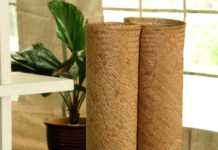Pre-European Aotearoa/New Zealand, a time when Māori baskets were prolific, used as containers for food storage, gathering shellfish, fern roots, ceremonial rituals, medicinal plants and serving food. Māori baskets are a combination of Polynesian weaving techniques.
 Māori baskets, known as kete (basket used as a carrying vessel), are varied. The differences are refined by their function from a kete kai (used for gathering food, including kete riwai for harvesting potatoes and kete kaimoana for collecting shellfish), kete pure (a basket that was used in performing a ritual or blessing), kete whakairo (a fine decorative patterned kete) to kete muka (delicate fine weaving made from muka, harakeke fibre).
Māori baskets, known as kete (basket used as a carrying vessel), are varied. The differences are refined by their function from a kete kai (used for gathering food, including kete riwai for harvesting potatoes and kete kaimoana for collecting shellfish), kete pure (a basket that was used in performing a ritual or blessing), kete whakairo (a fine decorative patterned kete) to kete muka (delicate fine weaving made from muka, harakeke fibre).
Harakeke/kōrari (phormium tenax) is the most common material used. Other native materials are pīngao (desmoschoenus spiralis), the golden sand sedge, and kiekie ( freycinetia banksii) an epiphyte. Kete made of these materials are unique to Aotearoa due to the versatility and strength of fibre content.
Techniques involve seasonal harvesting, stripping, softening, plying, boiling, dyeing and plaiting. The processes are dependent on the function of the kete.
The resurgence of Māori weaving has grown over the past thirty years. Te Roopu Rāranga/whatu o Aotearoa, the Māori weavers’ group is nationally recognised as one of the groups responsible for the resurgence. Founded by weaving practitioners such as Ngoi Pewhairangi, Emily Schuster OBE, QSM, Dr Diggeress Te Kanawa, CNZM, QSO, Cath Brown, Dame Rangimarie Hetet OBE, MBE, to name a few, whom have all passed.
Māori weaving is incorporated in education studies from certificate to postgraduate levels, developing artistic and contemporary styles. Works by Māori weavers are often exhibited in art galleries, museums, private studios and markets. Kete whakairo are given as gifts to guests and dignitaries, signifying technical skills and honour of the maker.
Baskets can be found at the Dowse Art Gallery, Kura Gallery, Arts Space Gallery, Museums – Te Papa Tongawera, Auckland War Memorial and Waikato. They feature in a few local town markets and the Annual Pacifika festival.
Further reading
Beever, J.1991. A Dictionary of Māori Plant Names. Auckland: Botanical Society.
Williams, M.A. 2005. Dictionary of the Māori Language. Wellington: Printlink.
Ka’ai, T M.2008. Ngoingoi Pewhairangi; A remarkable life. Wellington: Huia.
Wattereus, K. 1984. Māori and Pacific Island Weavers News. Wellington:MASPAC.





